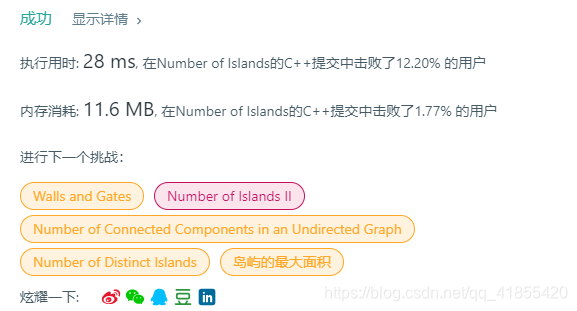社区微信群开通啦,扫一扫抢先加入社区官方微信群

社区微信群
社区微信群开通啦,扫一扫抢先加入社区官方微信群

社区微信群
给定一个由 ‘1’(陆地)和 ‘0’(水)组成的的二维网格,计算岛屿的数量。一个岛被水包围,并且它是通过水平方向或垂直方向上相邻的陆地连接而成的。你可以假设网格的四个边均被水包围。
示例 1:
输入:
11110
11010
11000
00000
输出: 1
示例 2:
输入:
11000
11000
00100
00011
输出: 3
思路分析:扫描整个矩阵,当我们的陆地(‘1’)时,就将与之相连的所以陆地标记,然后继续扫描。对于标记相邻的陆地,深度优先搜索、广度优先搜索都可以,这里只介绍广度优先搜索。
class Solution {
public:
int numIslands(vector<vector<char>>& grid) {
int resultCnt = 0;
int rowSize = grid.size();
if (rowSize == 0) {
return 0;
}
int colSize = grid[0].size();
if (colSize == 0) {
return 0;
}
//遍历整个矩阵,如果发现岛屿,则将与其相连的陆地全部标记
for (int row = 0; row < rowSize; ++row) {
for (int col = 0; col < colSize; ++col) {
if (grid[row][col] == '1') {
resultCnt += 1;
bfs(grid, row, col);//将这个岛屿标记
}
}
}
return resultCnt;
}
//用于将与grid[row][col]相邻的陆地全部标记为‘X’
void bfs(vector<vector<char>>& grid, int row, int col) {
int rowSize = grid.size(), colSize = grid[0].size();
queue<int> myQue;//广度优先遍历辅助队列
grid[row][col] = 'X';//标记
myQue.push(row);
myQue.push(col);
while (!myQue.empty()) {
row = myQue.front();
myQue.pop();
col = myQue.front();
myQue.pop();
if (row - 1 >= 0 && grid[row - 1][col] == '1') {//上方扩展
grid[row - 1][col] = 'X';//标记
myQue.push(row - 1);
myQue.push(col);
}
if (row + 1 < rowSize && grid[row + 1][col] == '1') {//下方扩展
grid[row + 1][col] = 'X';//标记
myQue.push(row + 1);
myQue.push(col);
}
if (col - 1 >= 0 && grid[row][col - 1] == '1') {//左方扩展
grid[row][col - 1] = 'X';//标记
myQue.push(row);
myQue.push(col - 1);
}
if (col + 1 < colSize && grid[row][col + 1] == '1') {//右方扩展
grid[row][col + 1] = 'X';//标记
myQue.push(row);
myQue.push(col + 1);
}
}
}
};

如果觉得我的文章对您有用,请随意打赏。你的支持将鼓励我继续创作!
